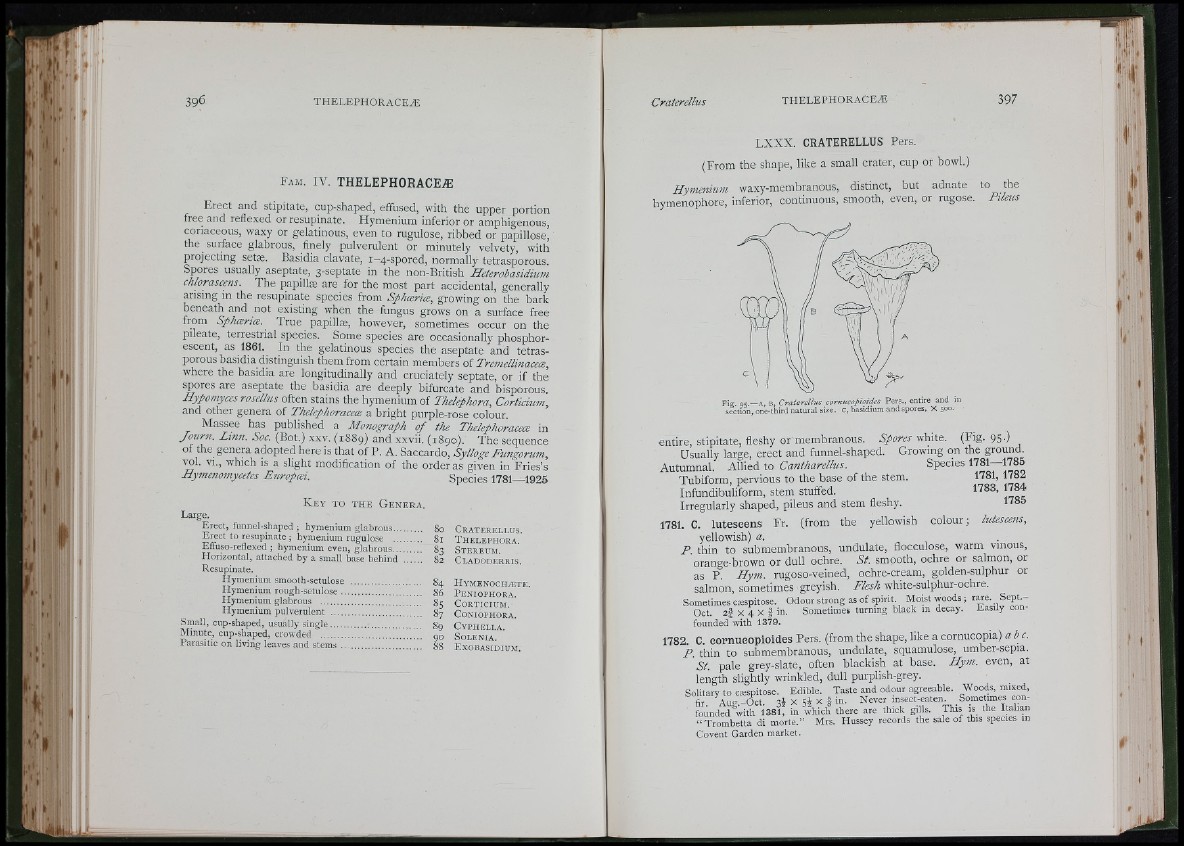
Fam. IV. THELEPHORACEÆ
Elect and stipitate, cup-shaped, effused, with the upper portion
free and reflexed or resupinate. Hymenium inferior or amphigenous,
coriaceous, waxy or gelatinous, even to rugulose, ribbed or papillose,
the surface glabrous, finely pulverulent or minutely velvety, with
projecting setæ. Basidia clavate, i - 4-spored, normally tetrasporous.
Spores usually aseptate, 3-septate in the non-British Heterobasidium
cMorascens. The papillæ are for the most part accidental, generally
arising m the resupinate species from Sphoeriæ, growing on the bark
beneath and not existing when the fungus grows on a surface free
from Sphæriæ. True papillæ, however, sometimes occur on the
pileate, terrestrial species. Some species are occasionally phosphorescent,
as 1861. In the gelatinous species the aseptate and tetrasporous
basidia distinguish them from certain members of Tremdlinaceæ,
where the basidia are longitudinally and cruciately septate, or if the
spores are aseptate the basidia are deeply bifurcate and bisporous.
Hypomyces rosellus often stains the hymenium of Thelephora, Corticium
and other genera of Thelephoraceæ a bright purple-rose colour.
Massee has published a Monograph of the Thelephoraceæ in
Journ. Linn. Soc. (Bot.) xxv. (1889) and xxvii. ( 1890). The sequence
of the genera adopted here is that of P. A, Saccardo, Sylloge Fungorum,
vol. V I., which IS a slight modification of the order as given in Fries’s
Hymenomycetes Europoei. Species 1781—1925
K ey to the Genera.
Large.
Erect, funnel-shaped ; hymenium glabrous......
Erect to resupinate ; hymenium rugulose ......
Effuso-reflexed ; hymenium even, glabrous......
Horizontal, attached by a small base behind
Resupinate.
Hymenium smooth-setulose ........................
Hymenium rough-setulose.............................
Hymenium glabrous .....................................
Hymenium pulverulent .................................
Small, cup-shaped, usually s in g le ..................................
Minute, cup-shaped, crowded ......................................
Parasitic on living leaves and stems ..................... !
80 C r a t e r e l l u s .
81 T h e l e p h o r a .
83 S t e r e u m .
82 C l a d o d e r r i s .
84 H y m e n o c h æ t e .
86 P e n io p h o r a .
85 C o r t i c iu m .
87 CONIOPHORA.
89 C y p h e l l a .
90 S o l e n ia .
88 E x o b a s id iu m .
LXXX. CRATERELLUS Pers.
(From the shape, like a small crater, cup or bowl.)
Hymenium waxy-membranous, distinct, but adnate to the
hymenophore, inferior, continuous, smooth, even, or rugose. Pileus
entire, stipitate, fleshy or membranous. Spores white. (Fig. 95.)
Usually large, erect and funnel-shaped. Growing on the ground.
Autumnal. Allied to Cantharellus. Species 1781—1785
1781, 1782
1783, 1784
1785
colour ; lutescens,
Tubiform, pervious to the base of the stem.
Infundibuliform, stem stuffed.
Irregularly shaped, pileus and stem fleshy.
1781. C. lutescens Fr. (from the yellowish
yellowish) a.
P thin to submembranous, undulate, flocculose, warm vinous,
orange-brown or dull ochre. X/. smooth, ochre or salmon, or
as P. Hym. rugoso-veined, ochre-cream, golden-sulphur or
salmon, sometimes greyish. Flesh white-sulphur-ochre.
Sometimes cæspitose. Odour strong as of spirit. Moist woods ; rare. Septa
Oct. 2| X 4 X § in. Sometimes turning black m decay. Easily confounded
with 1379.
1782. C. eornueopioides Pers. (from the shape, like a cornucopia) abc.
P. thin to submembranous, undulate, squamulose, umber-sepia.
St. pale grey-slate, often blackish at base. Hym. even, at
length slightly wrinkled, dull purplish-grey.
Solitary to cæspitose. Edible. Taste and odour agreeable. Woods, mixed,
fi, Aiiff-Oct s i X S i X 4 in. Never insect-eaten. Sometimes confounded
with 1381, in which there are thick gills. This is the Italian
“ Trombetta di morte.” Mrs. Hussey records the sale of this species in
Covent Garden market.
Li'
■I HIi